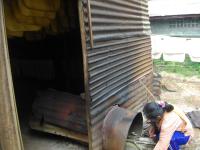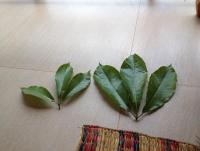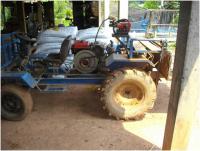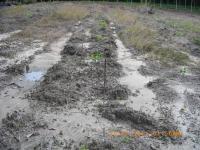-
Posts
74 -
Joined
-
Last visited
Content Type
Events
Forums
Downloads
Quizzes
Gallery
Blogs
Posts posted by tothemark
-
-
-
82 Baht for sheets today, I'm just happy we had some to sell.
Similar price to us up in Nong Khai province.
However, we are buying back in at this price and storing. Sub 90 is too little for matts for my liking.
Just built a smoker, nothing on a par with Jims industrial one, but a bit of tin and an oil drum - seems to work ok and reduces/stops the mould when you are storing sheet long term.
-
 tothemark, on 2012-05-11 10:36:02, said:
tothemark, on 2012-05-11 10:36:02, said:cdmtdm
Doing fine, growing fast thats for sure, if i get some pics sorted i'll try and upload. It will be interesting to see how they mature in the different soils, having just dug some ponds, the red clay dykes have had some jvp's planted on them, i am not expecting much from those but it s going to be interesting to compare the growth with those planted on the alluvial deposits.
ok cheers look forward to the pics mate
Hi cdmtdm,
Guys, i know its boring looking at rubber pics, so bare with me on this
 Its only because JVP80 is relatively new that I think its worthwhile giving feedback on it just in case it bombs lol
Its only because JVP80 is relatively new that I think its worthwhile giving feedback on it just in case it bombs lolThe two young rubber in the foreground of the first pic are both "real" jvp80 planted probably 8 months ago, note the more pear drop shape to the leaf and a larger canopy overall to the second pic which is a "fake" jvp80 and could be anything.
-
cdmtdm
Doing fine, growing fast thats for sure, if i get some pics sorted i'll try and upload. It will be interesting to see how they mature in the different soils, having just dug some ponds, the red clay dykes have had some jvp's planted on them, i am not expecting much from those but it s going to be interesting to compare the growth with those planted on the alluvial deposits.
-
Talking about JVP80, here is a cautionary tale.
The majority of our JVP80 were bought from a recommended (by the rubber co-operative) nursery, additional ones were also trucked up from Malaysia by a relative. We were, however, short of some more JVP80 and so the mil bought 15 (luckily) as a trial from a local nursery who assured her they were JVP80.
In the photo both examples are now the same age, having been grown further in our mini nursery, guess which one is the JVP80.
Needless to say when we bought another tranche we returned to the original supplier in Bueng Kan. So be warned.
-
Hi Fezzy,
North of Nong Khai, almost on the banks of the Mekong, jet ski country, lol
Used to be in Lampang for a while, just north of you so know your area a bit, love the hills there, sure miss them in these flatlands.
GL
-
Hey Fezzy, dont get giddy, the wife wont let you do any of those either, unless of course it has an Isuzu badge on the front. lol
What part of Los are you from, cos i want a go in it if you ever do
 ?
?Ken, the only way we will see a Unimog in Los is if the UN does a peace keeping visit and leaves some behind,

-
-
Ken, very nice, probably wont carry the weight i want to and will be more than i want to pay lol.
I had toyed with the idea of doing a conversion on a pick up, buying a well used Hi jet
 and replacing the engine with a kubota diesel 14hp - circa 20-30k for the engine and 40-60 for the hi jet, which funnily enough may even be documented for the road..
and replacing the engine with a kubota diesel 14hp - circa 20-30k for the engine and 40-60 for the hi jet, which funnily enough may even be documented for the road..Only one problem, im not there to do the work... But I do fancy having a punt at it
-
Haha Fezzy luv the first pic and your aptly named jpeg file.
Thanks for your answers guys.
Watersedge, you could be right, start from scratch with a 20,000 kubota engine, but thats a lot of work. Some jokers in Loei will make the drive train and frame minus the engine for 60,000, <deleted>, i could build it for a fifth of that.
I fancy the idea of a three wheeler www.carandclassic.co.uk/car/C124741
-
Yeah, does seem high, check with your local agricultural shop to see their price. Ours were left by the previous owner so they cant have been worth much !
There are many Thais who have given up doing mats, just ask around and you might fall on some second hand ones, we paid 16,000 for a kneeder fyi.
-
I am considering using an iron buffalo on the rubber farm, for trailering purposes between the trees and small scale ploughing on border land. The problem being that long handles on an iron buffalo cannot manoeuvre around closely packed trees
In order to make it work as a universal machine (and not have to buy two different machines) for my purposes i would need to change the steering from long handle to either steering wheel or small handlebar steering. My immediate thought would be to do this by converting the steering to chain drive via the use of one larger and one smaller sprocket to give it the correct ratio. To maintain balance of the tak tak i would have to fabricate a small ride on twin wheel step board welded to the tak taks frame that you could also attach a small trailer or other implement too.
We do have a relation that has done something similar which gave me the idea, although i havent seen it ! but his wife wont let him fabricate it for us, the joys of family strife, lol
I have seen the chain drive conversion on off road race cars many times in the past, it basically converts the rack to a quick rack and would be interested to know if anyone has seen any other fabrications in Los of the type im waffling about on iron buffalo tak taks to get round this steering issue ?
-
Hi Claus,
Yeah they do all the cutting in that price but leave you the stumps and the root system

-
Mark, My opinion for what its worth is, dont go for the strain that produces the highest yield on the assumption that even in the North a high yield strain will give a reasonable yield. As you say they are only just tapping in your area so yield figures cannot be relied upon. Just because you have a good looking thick trunk tree does not guarantee that it will give a good yield.
All those strains are best suited to different soils, height above sea level, temperate types, rainfall and drought types. Yes in Thailand especially in Isaan you can just about bang anything in and it will work reasonably well, Chiang Rai, needs a bit of homework, i wouldnt follow the herd.
Hi Barry, yeah my figure is high, but on 7 years with compound interest applied im not far from the Mark, to coin a phrase, Jim do you have your figures to hand based upon todays prices to confirm this?
We have used that "bat fertiliser" the sh i t obviously has a high nitrogen content, do we rate it ? no. Would we use it again ? no. Lot of myths about that one, but we had to have a go as well, lol
-
Hi Mark, know nothing about 226 trees, first I have heard of them. 251s fall over in the wind. How windy is it where you are, I am nor talking constant gales. One good blow can flatten a plantation. Tothemark is they only one I know of who is giving the JVPs a try.My wife plans to purchase and plant her Rubber trees next year.
One key question is which tree clone should she buy.
Currently she is planning RRIT 226 on sloping land, RRIT 251 on flat land.
Her land is about 1 hour North of Chiang Rai, 80% of the land is moderately sloping, 20% of her land is flat.
She will need about 16,000 trees so it's important she selects the right trees.
Rubber trees are a very recent development in Chiang Rai, the only trees currently being tapped in the area are RRIM 600.
My basic understanding of the 3 tree clones above is as follows:
RRIM 600. Tried and tested for many years, suitable on sloping & flat ground, 290Kg latex / year.
RRIT 226. Newer clone developed by Thai research institute, suitable on sloping & flat ground, 345Kg latex / year.
RRIT 251. Newer clone developed by Thai research institute, not suitable on sloping land 440Kg latex / year.
I am very interested in the new JVP80 clones but can't find any research / actual experience relating to this tree.
The JVP80 claims to yield 500 Kg of latex / year & have an extended 35 year tapping life.
I can't find any information regarding suitability in Northern Thailand, suitability on sloping ground, disease resistance, actual latex yield etc.
I think some of the members have already planted this tree, if they have any feedback it would be greatly appreciated.
Thanks
Mark
Think best you go to the local Agro dept. and ask them what's working in your area. They may not be the sharpest tools in the box. but at least they know what's falling over and what's not. Jim
Hi Jim/Mark,
We have about 10 rai of JVP80 growing now. It grows pretty quick thats for sure, its more expensive and buy only from a registered seller of the strain. My cousin in So Phisai has just bought some as well and they bought it directly from Malaysia and had it delivered direct. Better to do that rather than going through a government supplier such as we did, its quicker and knowing them it would have been cheaper.lol
But first, Mark, take a step back and consider what you are doing, my inlaws lived around Lampang and Mae Mao in Northern Thailand for many years before moving back to Isaan. My knowledge of that area is that there is very little rubber grown there and you have to ask the question why. Thais arent stupid, if they see an opportunity they copy it, so i would undertake some serious market research as to why they dont grow rubber in significant quantity in the North. My initial assumption would be that the temperate climate in the North especially Chiang Rai does not lend itself to profitable yields from the trees.
If you do go ahead with it and 200 rai is going to cost you circa 40,000bht per rai before you tap, (trees, fertilizer etc) you need to be very careful or you could lose a bucket load. Personally, I would spend time determining what strain is best suited to the climate of the north, not getting it right could break the project.
-
Last week we sold at 91b per kilo mats. Glad we did, cup then went down to 100b per three kilos and now they wont buy cup, similar to Jim's area.
Building up mats at the moment, bottom end for us will be 80bht a kilo below which we might as well store.
Bit of a p***** really as this is the most productive time for the trees normally doubling the yield.
-
Cup rubber at 40 bht a kilo and mats at 80 bht a kilo in our area today..
Thats a 20% drop in two days, hows everyone else finding prices ?
At this rate we are tempted to hold mats for a month or two and not sell.
-
Your better off uploading a photo of the trees and land, it might not just be the lack of fertiliser that's the reason for the lack of growth.
-
The deed is in my wife's name, as a way to support his children. But it is in the area where he has several other farms, so I guess he hopes that we sometimes will go and look after their farms, since we probably have to check up on our own anyway. I don't know the type of land title, but I'll try to see if my wife knows. Again, we know very little of this whole thing, and I hoped to get some input from this forum.
What is the difference between the various land titles?
There are differences as to ownership rules for Thais for various (weaker) land titles. Some titles can only be owned by Thai proletariat and on a few rare occasions land has been "reassigned" if the rules are broken.
Your wife owns the land and my understanding is that your interested in the idea of farming but not really committed to it as a complete lifestyle change. Coupled with the fact that both you and your family have no experience in rubber, I would give you the following advice to keep your sanity and no its not to sell,

In some instances where you have an absentee landowner, i have seen the Thais operate two alternate ways of having their farms "managed" :
1. Managing agent.
There are some farms that allow the farm to be managed by an agent who obtains a % of the income. Usually you will find that the agent will be managing three or more farms in the area, organising everything from staff to selling.
Without a doubt you will get "slippage" screwed as the yanks say, but how much is down to you and your involvement/appointment of the agent.
2. Lease
This would be my preference in your shoes.
Again in Thailand, some farms are leased out, lock stock and barrel and for your size i would estimate (once the trees are producing) you should get around 400,000bht per year leasing it out as a going concern and without having any of the associated problems of checking weekly returns.
The pitfalls to this is that if you lease it to a waster, they will not fertilise the trees properly, do too many and too large cuts and respect the trees similar to how a student respects his rented digs.
Again, its down to you to get the contract right and lease to the right person.
Your obviously weighing up your options which is a good way to tackle the issue rather than going in all guns blazing, good luck.
-
Well your fil is no fool that we can be certain about.
My feeling on the matter is that the fil couldnt care less about the fact that there's rubber on there, he has bought in Chanthaburi purely for long term investment. When you say he has given your wife the farm, do you mean the deeds as well, or has he given you a sitting (land) investment to manage and provide you (rather than him) with more stress than income ? If so then the fil's a sharp cookie.
For a pure rubber investment, yes its well overpriced, but i would presume he didnt buy it for that reason alone.
Out of interest what land title is it, Chanote perhaps ?
-
As a PS Mark seem to remember you were planting some JVP 80s, how are they going. We are thinking of ordering 600 for next year, to try. Jim
We are going to see if the rain stops and then make a decision re fertiliser, we are tempted to do it when there's been a five day lull in the rains, could have a long wait
 , but personally i dont want to see it flowing down the fields into the nearest mae nam.
, but personally i dont want to see it flowing down the fields into the nearest mae nam.Jvp's went in fine, had about a 10% fail or thereabouts, couldnt give you a reason why some died, the replacements took ok without any change to planting techniques. They are meant to be pretty hardy anyway especially when there's a drought, just be careful you dont get bullshitted and end up with duds/fakes, short term gain is so often long term misery in my book of accounts.
Hasnt stopped raining for 60 days and 60 nights, these jvp's will be hitching a lift with Noah soon.
-
Hi Jim,
Question for you, when are you doing your next fertiliser application on your trees ?
I have been looking at doing it a bit later than normal because of all the rain we are still getting, hows it down your way ? Most farms round here have just done theirs, the Mekong will be flowing luminous green because of that !
Mark
-
Hi all , a bit bored this morning and have a few hours to kill before I head out, so thought I would throw this in and see what people thought.
How much is a plantation really worth.
Now anyone who has read my posts will know I have a distaste for averages, but for this I will use them, plus will talk in US dollars, rather than Baht.
One rai land, say 70 producing trees. Making ribbed smoked sheet. Price $5 US a kilo [Know that's not today's price, but it was earlier and will be again, end of this year or next.] Average output allegedly 5 kilos per tree per year.
70 X 5 350 kilos per year. 350 kilos X $5 $1750 of rubber per year.
Now forgetting you are a farang, which has no relevance to prices. You are a man who can tap his own trees.
Man pays $3300 [ about 100,000 Baht] for that rai. Minus his costs, say $250 a year. He will have paid off his initial investment in under 3 years and own the trees and land.
Now I am no business man, but think you would be hard pushed to do the same in the west, whether in farming, buying a shop or gas station etc. Jim
My sentiments entirely Jim.
Anyone contemplating rubber should seriously consider purchasing a working plantation rather than starting from scratch with virgin land (unless of course they already own it and wish to keep it). Bearing in mind that semi forest rai is fetching up to 40,000 a rai at the moment, if you can buy established rubber currently producing at circa 100,000 a rai then its a no brainer, especially if the lumber is worth 40,000 (in time to come).
Jims calculations marry mine in that as Jim says, if you are the owner and tapper your return (based upon the higher price of rubber) is 33% p.a. If you employ a team on a split basis (50/50, 60/40) then your return is 15% p.a. These are the figures that I work to when buying established rubber. Stress testing the investment and allowing for rubber to fall by 50% to 40bht a kilo drops the return to 7.5%, still acceptable in my view.
Your investment is producing an income in baht and not from your country of origin (COO)and therefore you dont have the added loss of exchange rate variances in getting your money to Thailand. Additionally, you dont have to pay the punitive country of origin taxes (as its not in my name) you would be subjected to on the same rates of investment income if you invested in your COO.
But remember thats in a perfect world and running a plantation as a business is open to many, many variances that can affect that rate of return.
Jim you said you were rubbish at figures, what happened ?
-
Having a house on SPK land is not legal, the title allows for a workers hut not a large family dwelling. I know that Thais and farangs build and in most cases have no trouble, but in reality you need planning permission just like in the west, and you won't get it. You only need one jealous neighbor with a bit of pull to complain, bye bye house. Don't think it doesn't happen. Even out in the boonies where I live things are changing fast.
Ken interesting what you are saying about the Government up grading titles, hasn't started here yet, but a win win if you already have the land. The BIL who works for the local Government was saying last year, that if we have any money we should be buying possession land, no title at all, just land that people have been farming. Didn't get it at the time, but if they are converting farm land to charnote, there may be something to what he is saying. Jim
We have been told similar Jim, make sure that you pay your land tax on Sor POr Kor every year in the same name that the "new" owner is now registered, i.e. your wife. Maybe, and its just a maybe it will put one in a strong position IF Sor Por Kor does get a regraded land title.
Gary A, wheres that come from ? Do you have a link ?
Somo, thats a good point about the documents. The other one to remember is if you are buying the SPK from someone who has bought it from the original owner, i.e further down the chain, you must get a contract where the original owner also agrees to have "sold" it to you, not just the person you are buying it from. As I said get a good land lawyer and best to buy SPK with the view that you farm it to keep in the family for good.










Rubber Trees
in Farming in Thailand Forum
Posted
Mosha,
You can buy some powder from the fertiliser shop to sprinkle on the mats before you stock pile them its circa 100bht a bag. Dont stack them too high as they fuse together and a big pile to unfuse is a bstard. Make sure they are off the ground on pallets if possible to give it some airflow.
We stored non smoked from Dec till May, small bit of mould and we got knocked back about 2bht a kilo because of it, but it was still worth doing and we are doing the same now but with smoked.
GLA